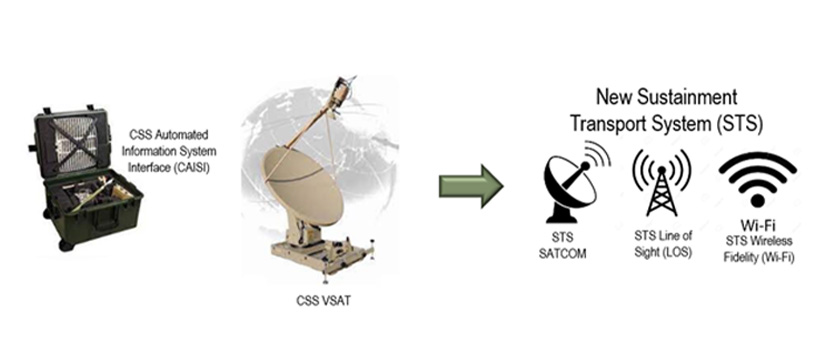
Sustainment Transport System (STS) will provide expeditionary, easy to use, secure global data transfer for the logistics community -- including logistics, personnel, medical and force protection data -- to enable the rapid delivery of the right supplies and personnel to the right locations on the battlefield. Developed for the general purpose user, these easy to deploy network transport systems will provide the resilient, high-capacity connectivity needed to enable the exchange of critical logistics information worldwide.
The legacy logistics network program, known as the Combat Service Support (CSS) network, has been in operation since 2004. CSS runs over a commercial network design, completely separate from the Army’s tactical network. PdM UNCI is working with numerous Army Stakeholders and industry to converge the legacy logistics network onto the tactical network, an effort known as Transport Convergence. The eventual modernized and converged logistics network capability will be known as STS. PdM UNCI will continue to manage legacy CSS systems until the STS network systems are fully fielded.
To support STS, commercial Very Small Aperture Terminals (VSATs) will provide the tactical network transport needed to enable global data exchange for the Army’s logistics information systems and applications, such as Enterprise Resource Planning (ERP), Global Combat Support System-Army (GCSS-Army), Integrated Personnel and Pay System-Army (IPPS-A), Medical Communication for Combat Casualty Care (MC4) and General Fund Enterprise Business Systems (GFEBS). STS could also potentially include high-capacity line-of-sight and secure wireless transport to support these systems across a localized logistics support location.
As part of the Army’s two-year interval network Capability Set (CS) acquisition process, PdM UNCI is conducting early lab and field-based experimentation and Soldier assessments to inform capability and design requirements needed to modernize the legacy logistics network. As part of the process, Soldier feedback is helping to inform near-term Army requirements and future acquisition decisions for an STS solution that is secure, affordable, and in-line with the Army’s network modernization priorities.
On the current timeline, following future acquisition decisions, the service plans to begin fielding STS capability to units in FY23, as part of CS23, the second installment in the Army’s iterative two-year network modernization capability set acquisition and fielding process. CS23 builds upon CS21 advances in expeditionary capabilities and intuitiveness, to increase network capacity, resiliency, and convergence.
Capabilities
- Secure high-capacity global tactical network transport
- Fully integrated into the Army’s unified network
- Leverages the Regional Hub Nodes and Global Agile Integrated Transport (GAIT)
- Auto-acquire satellite terminals
- Easy to use for general purpose user
- Easy to transport for rapid deployment and battlefield mobility
- Supports Army Enterprise Resource Planning solutions